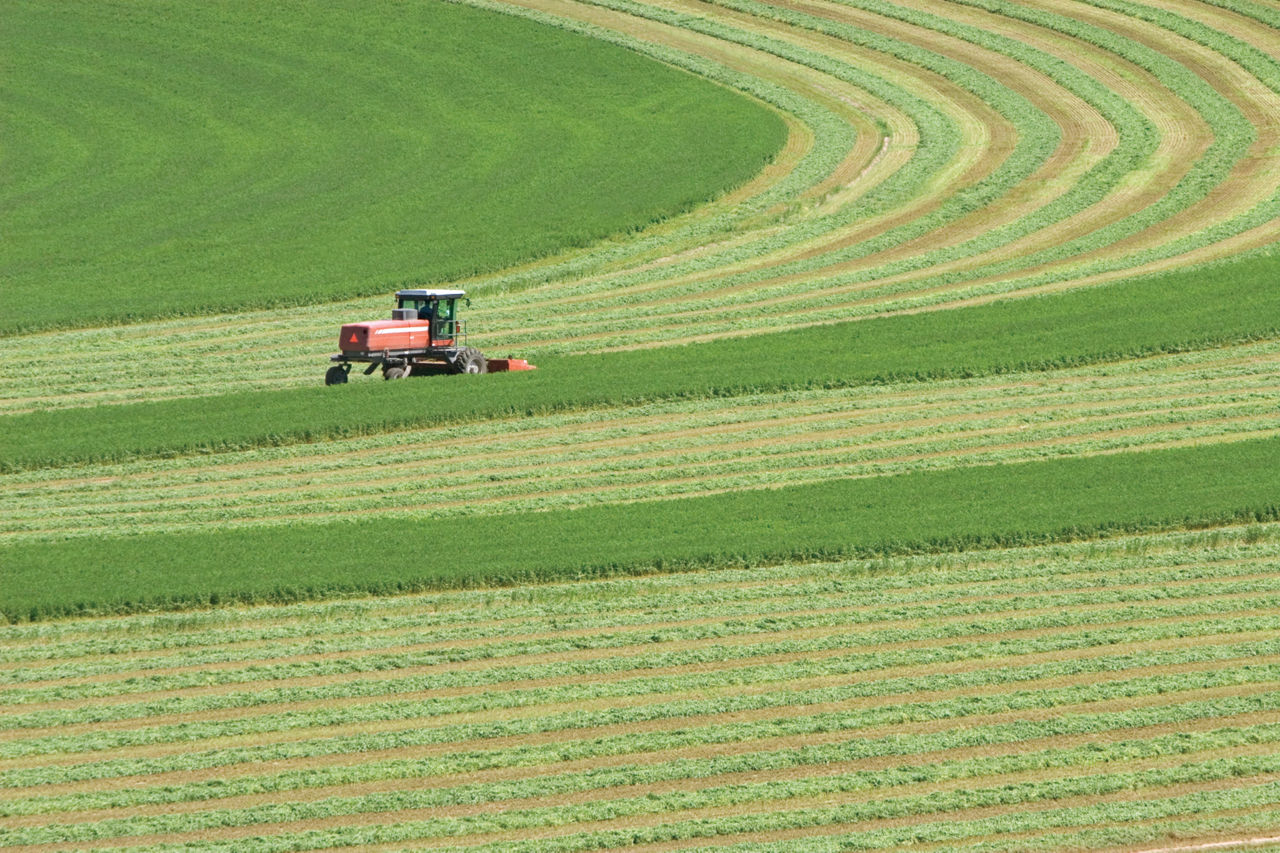3 MIN READ
Alfalfa Harvest Timing and Frequency
October 15, 2020
- Timing alfalfa cutting is the most important management practice to maximize tonnage potential, quality, and profitability of an alfalfa crop.
- A late summer alfalfa cutting should occur early enough so plants can regrow, produce, and store carbohydrates in the roots and crowns before entering fall dormancy.
- Reduced lignin alfalfa products may help improve forage quality while maintaining or potentially increasing yield.
Alfalfa Carbohydrate Reserves
Carbohydrates (CHOs) produced through photosynthesis are stored in alfalfa roots and crowns to help develop cold hardiness and survive winter temperatures. In the spring the stored energy is used to initiate growth after dormancy and continued growth after each cutting. The use of stored CHOs slows when plants reach 6 to 8 inches in height because the plants can produce CHOs during photosynthesis. At this stage, more energy is produced and stored in the roots and crowns than used for growth. Storing CHOs continues and reaches their highest level at about full flower.
Timing Alfalfa Cuttings
Challenges may occur during the growing season that may cause the last cutting of the season to be late. When harvesting late, it is important to follow best management practices (BMPs) for the future success of the crop. The timing of a single cutting should not be made without considering the impact on future seasonal cuttings as several agronomic and marketing factors should be considered. The number of possible alfalfa cuttings varies by environmental conditions, field location, alfalfa product selection, and other management considerations. Key factors to also consider when determining harvest intervals include total seasonal tonnage potential, forage quality, the price spread between different quality categories, marketability of the crop, and the impact of cutting schedule on stand survival. A late summer alfalfa cutting should be done early enough so plants can regrow, produce, and store adequate CHO reserves or be cut so late that plants do not regrow. This can help plants survive winter temperatures and use the stored CHO to regrow in the spring. Research has shown that a late fall cutting can be done if fewer than 200 Growing Degree Days (GDDs) occur after the cutting to prevent regrowth and depletion of stored CHOs.1 If regrowth is desired prior to winter dormancy, about 500 GDDs are required to provide sufficient regrowth.
Yield vs. Quality Tradeoff
Deciding when to cut can be a difficult decision and no single cutting schedule can fit all situations. Alfalfa tonnage and quality potentials are almost always inversely related to a growth cycle.2 Shorter cutting intervals generally reduce tonnage potential and increase forage quality. Conversely, longer cutting intervals usually increase tonnage potential and reduce forage quality. As alfalfa matures, the quality decreases because the stem weight increases and lignin (tissue to help standability) becomes increasingly indigestible. Cutting alfalfa at immature growth stages can shorten the stand life, reduce plant health and population, and aid in the increase of weed populations.2 The need for quality versus tonnage depends on an operation's feed requirements or marketing if selling for revenue. Higher quality may add additional nutritional value while less cutting could increase tonnage. Seasonal or yearly alfalfa prices may support cutting more for tonnage over quality; however, the end user's needs should be considered. Therefore, cuttings should be flexible to market and user conditions.
Reduced Lignin Alfalfa
Reducing the lignin content in alfalfa can increase digestibility for livestock and expand the harvest window, which can allow growers to delay harvest for a high yield potential while maintaining a high quality alfalfa product.4 HarvXtra® Alfalfa with Roundup Ready® Technology is a biotechnology-derived alfalfa product designed to ease the tonnage versus quality trade-off. To realize the full potential of a HarvXtra® Alfalfa with Roundup Ready®Technology product, the first cutting should be harvested at the generally accepted time for conventional alfalfa products. The later cuttings can be delayed 7 to 10 days because the reduction in lignin allows for quality to be comparable to the first cutting and tonnage potentially higher because of taller plants.

Sources
1Undersander, D. 2012. Late summer cutting management of alfalfa. University of Wisconsin. https://fyi.extension.wisc.edu/forage/late-summer-cutting-management-of-alfalfa-3/.
2Orloff, S.B. and Putnam, D.H. 2007. Harvest strategies for alfalfa. Irrigated Alfalfa Management for Mediterranean and Desert Zones. University of California. Publication 8299.
3Orloff, S. and Putnam, D. Balancing yield, quality and persistence. Proceedings, National Alfalfa Symposium, 13-15 December 2004 San Diego, CA, UC Cooperative Extension. University of California, Davis.
4Grev, A.M., Wells, M.S., Martinson, K.L., Samac, D.A., Sheaffer, C.C., Undersander, D. 2018. Reduced-lignin alfalfa varieties. University of Minnesota. https://extension.umn.edu/forage-variety-selection/reduced-lignin-alfalfa-variet-ies#:~:text=HarvXtra,in%20a%20lignin%20synthesis%20pathway.
Combs, D. 2016. Low-lignin alfalfa varieties offer potential quality gains. Hay & Forage Grower®. https://www.hayandforage.com/article-490-Low-lignin-alfalfa-varieties--offer-potential-quality-gains.html.
Web sources verified 07/31/2020. 7010_S3